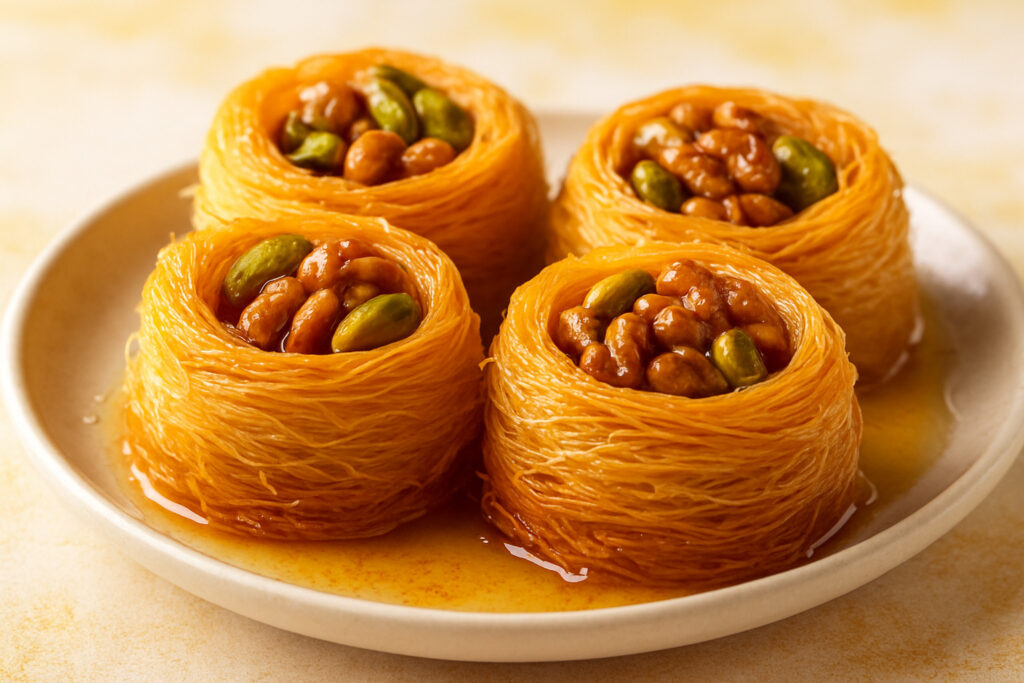Finding the Delicate Art of Kataifi Pastry
Kataifi is a unique Mediterranean pastry made from ultra-thin, vermicelli-like strands that crisp up beautifully when baked. This shredded dough creates stunning nests, wraps, and layers in both sweet and savory dishes across Greek, Turkish, and Middle Eastern cuisines.
Quick Kataifi Facts:
- What it is: Shredded pastry dough with hair-thin strands
- Texture: Crispy when baked, similar to toasted vermicelli
- Uses: Sweet desserts with nuts and syrup, savory wraps with cheese or seafood
- Pronunciation: ka-ta-IF-ee
- Also called: Kunafa, kadayif, or shredded filo
- Where to find: Mediterranean grocery stores, frozen section
Unlike regular phyllo dough sheets, kataifi pastry forms delicate threads that wrap around fillings like edible string. The strands are created by dripping crepe-like batter onto a rotating heated plate – a technique that produces the signature threadlike texture.
For culinary travelers seeking authentic Mediterranean experiences, kataifi opens doors to traditional desserts like honey-soaked walnut nests and modern fusion creations like kataifi-wrapped prawns. Whether you’re exploring a Greek taverna or experimenting in your own kitchen, this versatile pastry adds both visual drama and satisfying crunch to any dish.
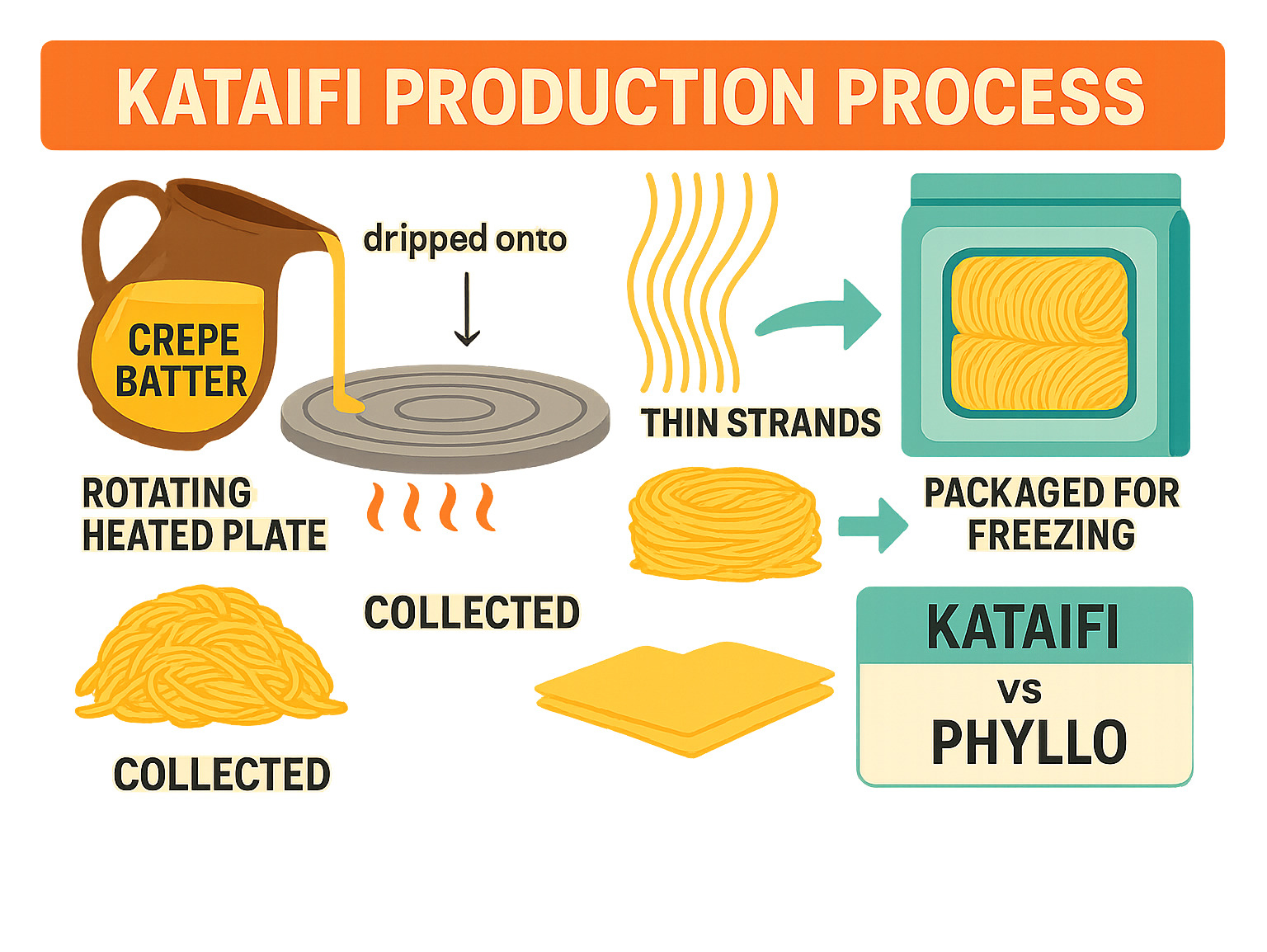
Related content about kataifi:
What Is Kataifi Pastry?
Kataifi pastry creates culinary magic through its unique production method that sets it apart from every other pastry you’ve encountered. Instead of rolling dough into sheets like phyllo, kataifi emerges as delicate, vermicelli-like strands that look almost like edible angel hair.
The secret lies in a fascinating technique called the batter drip method. A crepe-like batter gets dripped onto a rotating heated metal plate, instantly forming those signature threadlike strands. It’s like watching pasta being made, except the result is pastry that crisps beautifully when baked.
You’ll hear kataifi pronounced as ka-ta-IF-ee, with the emphasis on that final syllable. Don’t be confused if you see it called kunafa in Middle Eastern restaurants or kadayif in Turkish cuisine – they’re all referring to this same wonderful shredded pastry. The names might change, but that distinctive vermicelli texture remains constant.
| Feature | Kataifi | Phyllo Dough |
|---|---|---|
| Appearance | Thin vermicelli-like strands | Paper-thin flat sheets |
| Texture | Soft and pliable when thawed | Crisp and brittle |
| Production | Batter dripped on heated plate | Rolled and stretched thin |
| Uses | Wrapping, nesting, layering | Layering, folding |
| Handling | Needs damp towel covering | Needs damp towel covering |
What makes kataifi so special is how those fine strands behave when you cook with them. They wrap around fillings like edible string, creating stunning nests for nuts and honey or neat parcels for seafood and cheese. The texture transforms from soft and pliable to gloriously crispy, adding both visual drama and satisfying crunch to your dishes.
Origins & History of Kataifi
The story of kataifi winds through centuries like its own delicate strands, connecting cultures across the Mediterranean and Middle East. Food historians have found references to similar shredded pastries dating back to the 10th century, though they still debate whether those early descriptions match our modern kataifi.
One captivating origin theory points to Egypt, where clever bakers supposedly created this pastry to feed large crowds during religious festivals. The lightweight, filling nature of kataifi made it perfect for feeding worshippers efficiently. From there, the Ottoman Empire’s vast trade networks carried this culinary innovation across their territories.
As documented in the Encyclopedia of Jewish Food, kataifi found its way into various cultural cuisines through migration and cultural exchange. Greek cooks acceptd this foreign pastry so completely that it became essential to their dessert category called syropiasta – literally meaning “bathed in syrup.”
The diaspora spread of Mediterranean communities brought kataifi to distant shores, including New York City, where food lovers can now find authentic versions in specialty shops. This journey shows how truly great ingredients transcend borders, adapting to new kitchens while maintaining their essential character.
How Kataifi Dough Is Made Commercially
Commercial kataifi production combines old-world technique with modern precision in a process that’s mesmerizing to watch. Everything starts with a carefully balanced crepe-like batter made from flour, water, and often a touch of cornstarch for extra tenderness.
The real magic happens when this batter gets dripped in thin, continuous streams onto a large rotating heated metal plate. The timing must be perfect – each strand cooks for mere seconds before being gathered by industrial shredders that collect the delicate threads into loose bundles.
Modern producers use specialized equipment that maintains consistent strand thickness and texture, something that would be nearly impossible to achieve by hand. The fresh kataifi gets quickly packaged while still warm, then frozen immediately to lock in that perfect texture.
You’ll typically find kataifi in the freezer section packaged in standard 16-ounce (450-gram) bundles – just right for most home recipes. These frozen packages stay fresh for 2-3 months, making it possible for home cooks everywhere to experiment with this Mediterranean treasure. The freezing and packaging process has revolutionized access to kataifi, bringing restaurant-quality ingredients to home kitchens worldwide.
Classic Sweet & Savory Dishes with Kataifi
Kataifi pastry transforms ordinary ingredients into extraordinary culinary experiences, whether you’re crafting traditional honey-soaked desserts or modern fusion appetizers. This versatile pastry acts like baklava’s more textured cousin, creating stunning visual presentations that taste as good as they look.
The beauty of kataifi lies in its ability to form perfect nests for sweet fillings or wrap around delicate ingredients like a golden, crispy blanket. In Greek cuisine, ekmek kataifi stands as one of the most beloved desserts, layering crispy shredded pastry with rich custard and fluffy whipped cream for a texture symphony that melts in your mouth.
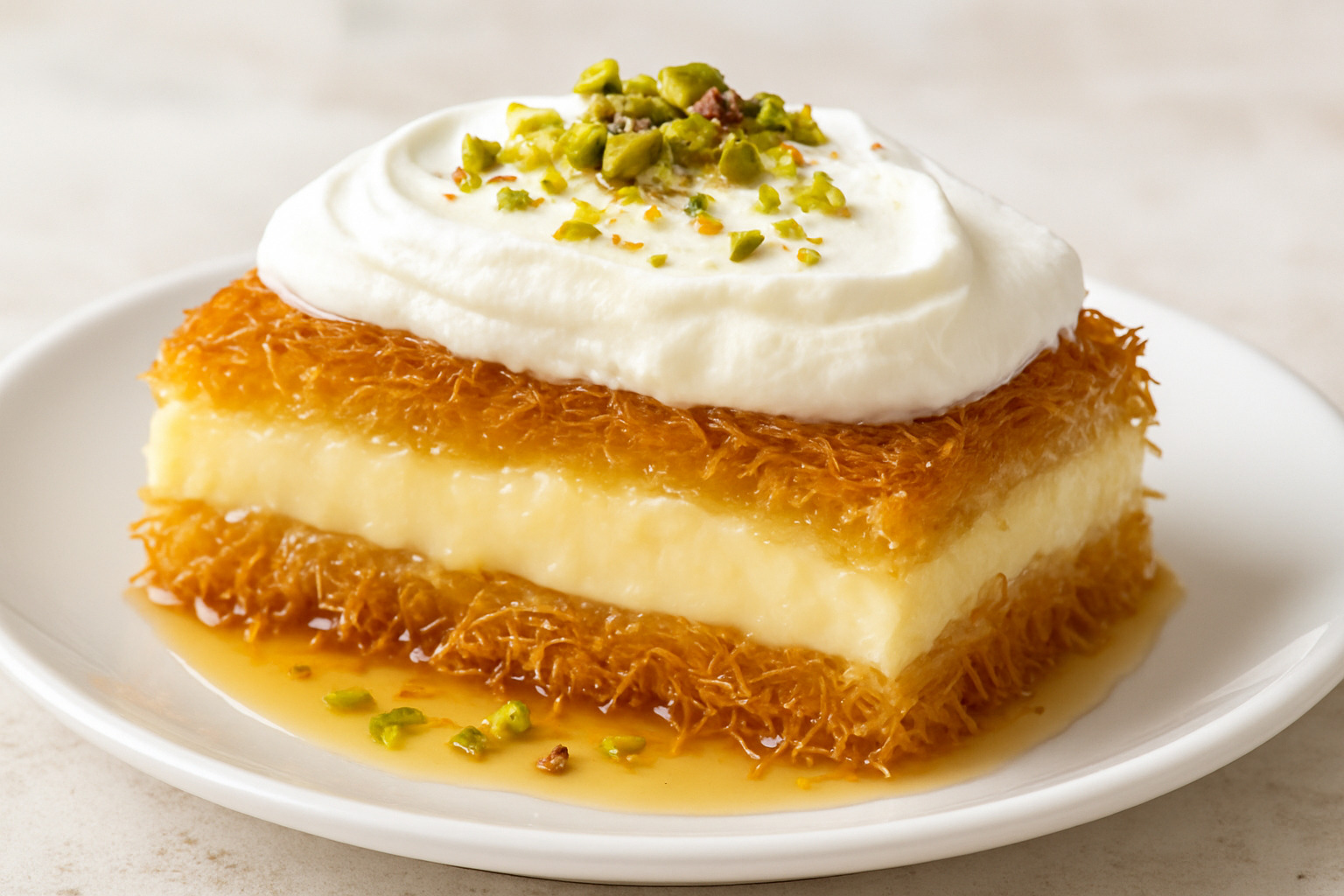
Middle Eastern kitchens showcase kataifi in knafeh, where the pastry creates a golden foundation for creamy cheese filling. Turkish preparations often feature crushed pistachios and aromatic rosewater, while Lebanese versions might include the delicate fragrance of orange blossom water in their syrups.
From neat pistachio rolls to hearty meat parcels, kataifi adapts to both sweet and savory applications with remarkable ease. Modern chefs have finded its potential for creating show-stopping shrimp wraps and cheese cigars that bring Mediterranean flair to contemporary mezze platters.
Signature Sweet Treats Featuring Kataifi
The world of sweet kataifi desserts belongs to the cherished Mediterranean tradition of syrupy treats that satisfy both the eyes and the palate. These desserts typically feature the pastry formed into nest shapes, creating perfect pockets for rich fillings of chopped walnuts, almonds, and warming spices like cinnamon and nutmeg.
The classic preparation involves mixing about 300 grams of mixed nuts with fragrant cinnamon, then nestling this mixture into kataifi nests before baking until golden. The magic happens when you drizzle the hot pastry with honey or sugar syrup infused with rosewater, creating that signature Mediterranean sweetness.
Pistachio rolls represent another beloved variation, where the delicate strands wrap around ground pistachios and honey for an neat presentation. Some modern Greek restaurants pair these desserts with vanilla ice cream, creating a delightful temperature contrast that improves both the warm pastry and cool cream.
These indulgent treats pack about 297 calories per serving, with 17.9 grams of fat and 20.8 grams of sugar. While they’re certainly special occasion desserts, the nuts provide beneficial protein and healthy fats alongside the sweet satisfaction. The combination works beautifully with strong Greek coffee or aromatic tea.
Savory Stars Wrapped in Kataifi
Kataifi’s crispy texture has found a starring role in savory Mediterranean cooking, where it transforms simple ingredients into restaurant-worthy presentations. The pastry’s ability to create a golden, crunchy exterior while keeping fillings moist and flavorful makes it a favorite among both home cooks and professional chefs.
Kataifi prawns showcase this technique beautifully – large shrimp wrapped in the delicate strands and fried until the pastry turns golden and crispy. The result looks like neat seafood lollipops that make perfect party appetizers or sophisticated starters for dinner parties.
Greek cooks love creating feta bundles by wrapping the tangy cheese with fresh herbs like dill or mint before encasing everything in kataifi and baking until crispy. These bite-sized treats work wonderfully on mezze platters alongside olives, tomatoes, and crusty bread.
Creative modern applications include using kataifi as a pie topping instead of traditional pastry crusts, adding wonderful textural interest to savory pies filled with spinach, cheese, or meat. Some chefs even create meat parcels by wrapping seasoned ground lamb or beef in the pastry for a unique twist on traditional Mediterranean flavors.
These savory preparations prove that kataifi isn’t just for dessert – it’s a versatile ingredient that brings both visual drama and satisfying crunch to any meal.
Mastering Kataifi at Home
Working with kataifi at home might seem intimidating at first, but once you understand its gentle nature, you’ll find it’s quite forgiving. The secret to success lies in treating those delicate strands with respect and following a few simple techniques.
Thawing is everything when it comes to kataifi pastry. Remove your frozen package from the freezer and let it defrost overnight in the refrigerator while still sealed in its original packaging. This slow, gentle process prevents the strands from becoming either brittle or sticky. Once it’s defrosted, allow it to come to room temperature for about 1-2 hours before opening the package.
The moment you open that package, you’re working against time – but don’t panic! Keep any unused kataifi covered with a damp towel to prevent those beautiful strands from drying out. Work gently but confidently, separating the strands with your fingers like you’re fluffing cotton candy.
Before baking, brush your assembled kataifi generously with melted butter. This isn’t just for flavor – it’s what creates that gorgeous golden color and satisfying crispy texture we all love. Don’t be shy with the butter; those strands are thirsty!
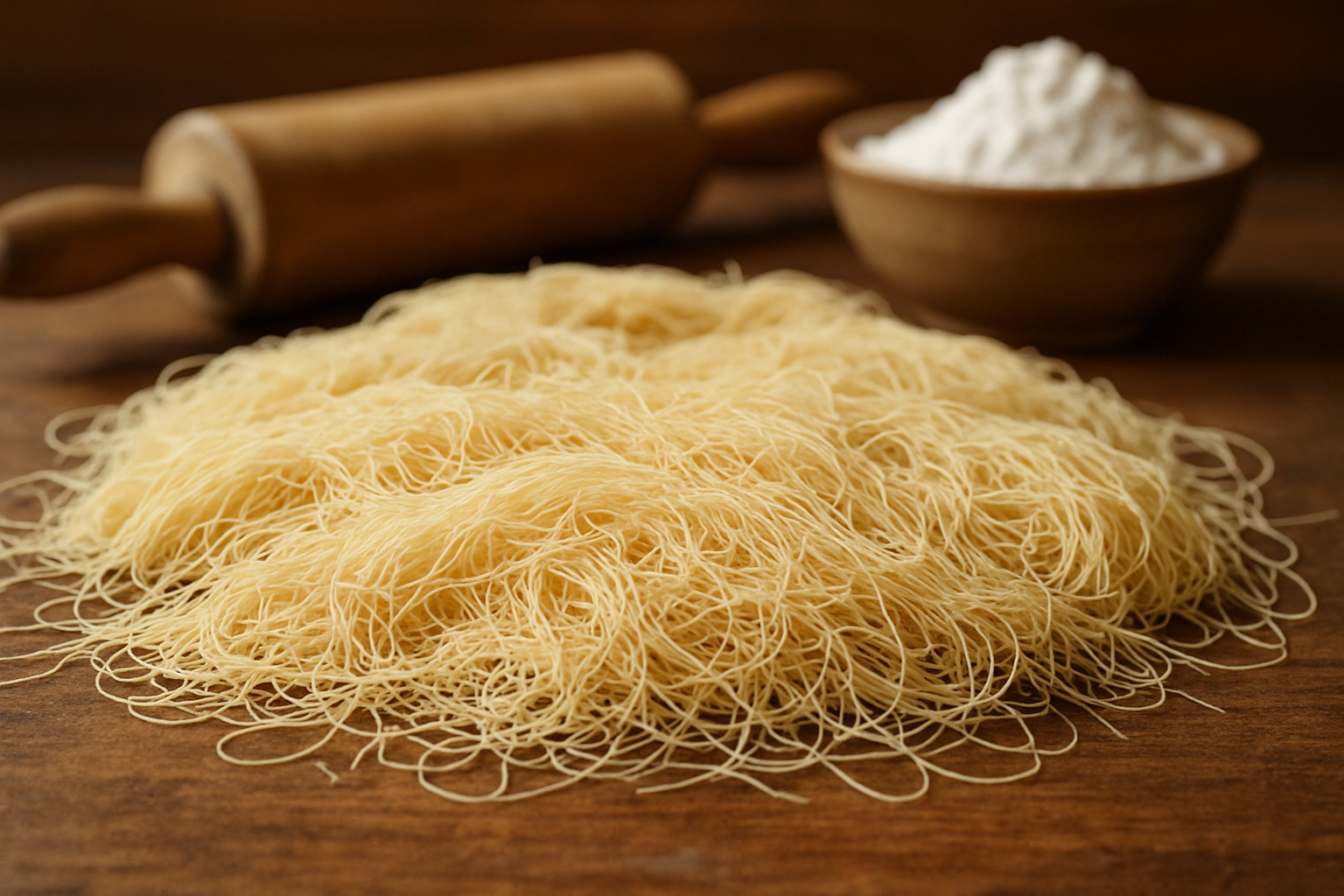
For storage, kataifi is wonderfully accommodating. You can assemble dishes ahead of time and freeze them for up to 2-3 months when wrapped tightly in plastic. This makes it perfect for entertaining – imagine having homemade Mediterranean desserts ready to pop in the oven when guests arrive!
Simple Homemade Kataifi Recipe
Making your own kataifi from scratch is like performing a little kitchen magic. While store-bought packages can cost around $25, making your own costs just a few dollars and gives you bragging rights that money can’t buy.
You’ll need basic pantry staples: 3/4 cup all-purpose flour, 2/3 cup cornstarch, 1 teaspoon sugar, 1/2 teaspoon salt, 1 tablespoon neutral oil, and 1 cup water. The equipment is equally simple – a fine sieve, mixing bowl, whisk, piping bag (or a plastic bag with the corner snipped off), and a non-stick pan.
Start by sieving your flour and cornstarch twice – this step eliminates any lumps that could ruin your delicate strands. Whisk the dry ingredients together, then add the oil and water. Your batter should look like thin pancake batter, smooth and pourable.
Heat your non-stick pan on low heat – patience is key here. Fill your piping bag with batter and pipe thin circles or zigzag patterns onto the warm surface. Each strand cooks for just 5-10 seconds until it sets. Remove gently with a spatula and immediately cover with a kitchen towel to keep the strands pliable.
This recipe yields approximately 120-140 grams of fresh kataifi – enough for several dessert servings. Any leftovers can be frozen in a freezer-safe container for up to 3 months, giving you homemade kataifi whenever inspiration strikes.
Common Mistakes & Troubleshooting
Even experienced home cooks sometimes struggle with kataifi, but most problems have simple solutions. When your strands turn out too thick, it’s usually because your batter needs thinning with a little water, or your piping hole is too large. Adjust accordingly and try again.
Dry, brittle dough happens when the strands get exposed to air too long. Always keep your kataifi covered with that damp towel and work quickly during assembly. Think of it like working with phyllo dough – speed and moisture are your friends.
Uneven browning frustrates many home bakers, but it’s typically caused by inconsistent butter application or oven hot spots. Brush every surface thoroughly with melted butter and rotate your pan halfway through baking for even golden color.
Nobody wants a soggy bottom on their beautiful kataifi creation. This happens when hot pastry meets hot syrup, creating steam that makes everything mushy. Always let your syrup cool completely before pouring it slowly over the hot pastry, allowing each addition to absorb before adding more.
Getting the syrup temperature right is crucial for that perfect texture contrast – crispy top, moist interior. Hot syrup on hot pastry equals disappointment, so patience pays off here.
Storing & Serving Kataifi Desserts
Your beautiful kataifi creations deserve proper care to maintain that delightful contrast between crispy exterior and tender, syrup-soaked interior. Room temperature storage works best for this balance – refrigeration can make the pastry disappointingly soggy.
Store finished kataifi desserts in airtight containers at room temperature for 4-5 days maximum. The bottom layer will naturally become softer as it absorbs the aromatic syrup, while the top should maintain some of its satisfying crunch. If the top loses its crispiness after a day or two, pop it in a low oven at 200°F for 5-10 minutes to restore some texture.
Traditional Greek serving style includes a small cup of strong Greek coffee alongside your kataifi – the bitter coffee beautifully balances the sweet, nutty flavors. Many people also love adding a scoop of vanilla ice cream, creating a wonderful temperature contrast that makes each bite exciting.
For more inspiration on creating memorable dining moments at home, explore our comprehensive best culinary experiences guide.
Modern & Global Twists on Kataifi
The world of kataifi has exploded beyond traditional Mediterranean kitchens, with creative chefs and home cooks finding exciting new ways to use this versatile pastry. The viral Dubai chocolate trend perfectly showcases this evolution – where kataifi gets wrapped around rich chocolate ganache and pistachios, creating those satisfying ASMR-worthy crunches that have taken social media by storm. The best part? Making this trendy treat at home costs a fraction of what you’d pay at a fancy chocolate shop.
Contemporary fusion cuisine has truly acceptd kataifi’s unique texture and appearance. One innovative chef described their kataifi cheesecake creation as “the missing link between baklava and cheesecake” – combining the familiar comfort of cream cheese with honey and pistachios wrapped in crispy pastry threads. It’s this kind of creative thinking that’s bringing traditional ingredients into modern kitchens.
The sushi-inspired approach has been particularly fascinating to watch develop. Chefs are rolling kataifi around both sweet and savory fillings, creating dishes that look like sushi but taste completely different. These rolls work beautifully as party appetizers or unique dessert presentations.
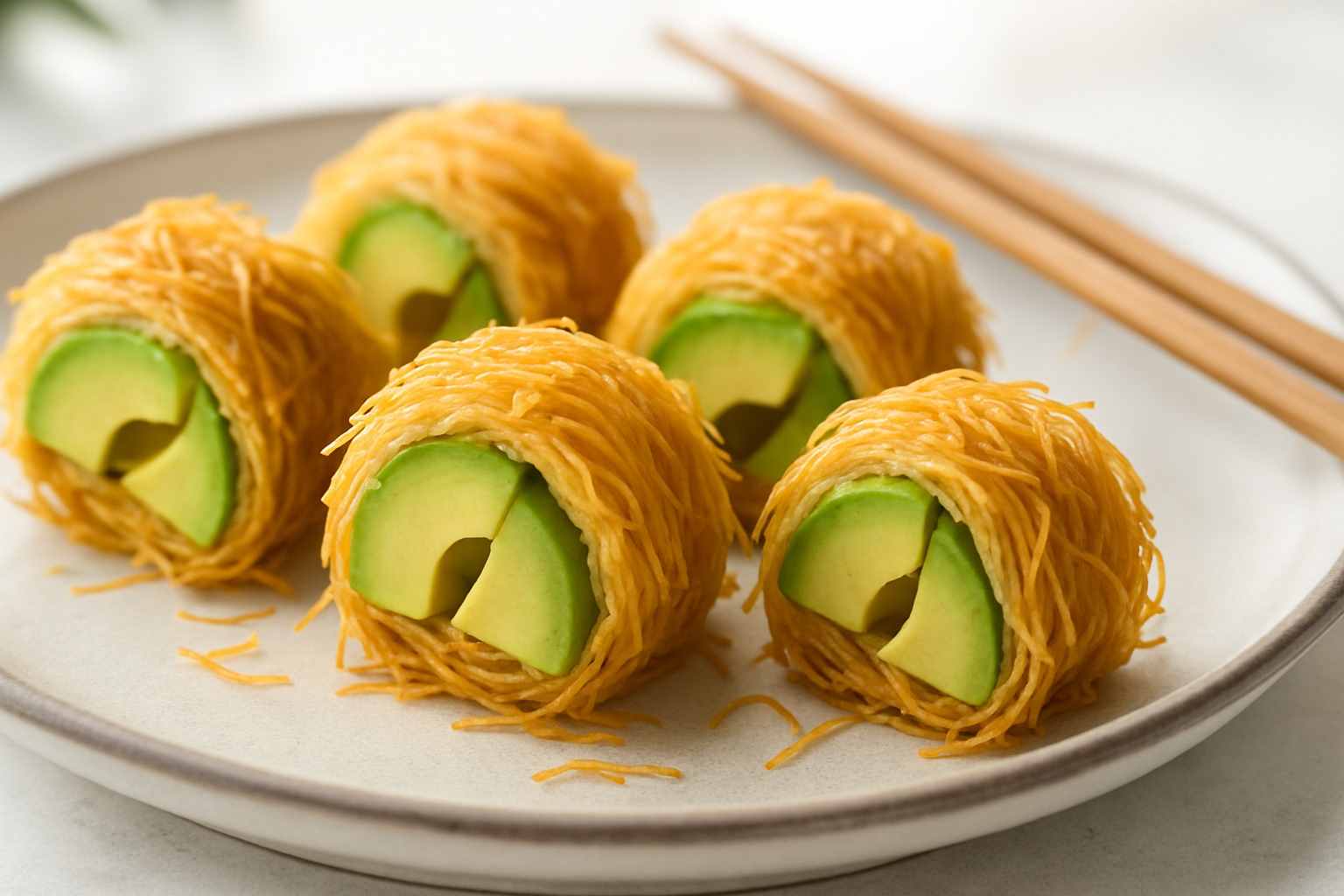
Plant-based cooking has found a natural friend in kataifi pastry. Vegan versions using cashew cream, dates, and nuts create desserts that are just as satisfying as traditional recipes. The sustainable dining movement appreciates kataifi’s minimal processing requirements and the fact that it can showcase plant-based ingredients beautifully.
Chocolate integration has become another exciting frontier. Beyond the Dubai chocolate bars, creative cooks are wrapping kataifi around chocolate-dipped strawberries, creating ganache-filled nests, and even using it as a textural element in modern chocolate desserts. The contrast between the crispy pastry and smooth chocolate creates an irresistible combination.
These modern interpretations prove that traditional ingredients can evolve and adapt while keeping their essential character intact. For more inspiration on global culinary trends and fusion techniques, explore our World Cuisine Exploration guide.
Nutritional Profile & Dietary Notes
Understanding what goes into your kataifi creations helps you make choices that fit your lifestyle and dietary needs. The pastry itself is surprisingly neutral nutritionally – it’s mainly carbohydrates from flour with very little fat. The real caloric impact comes from what you add: the butter for crisping, the nuts for filling, and those sweet syrups that make everything delicious.
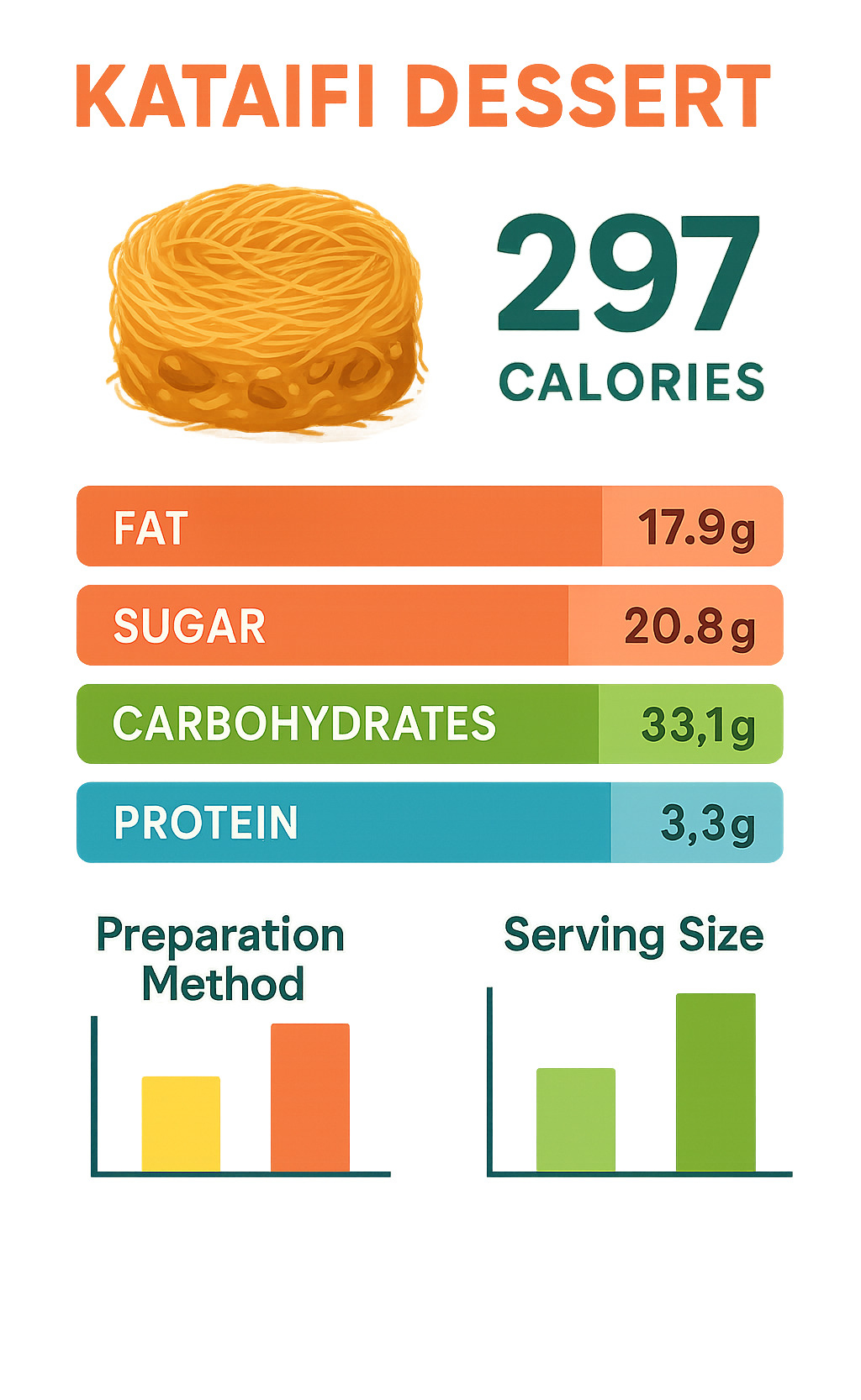
A typical kataifi dessert serving contains about 297 calories, with 17.9 grams of fat (mostly from nuts and butter), 33.1 grams of carbohydrates, and 20.8 grams of sugar from the syrup. The protein content sits at around 3.3 grams, mainly from the nuts used in fillings.
For those watching their gluten intake, traditional kataifi does contain wheat flour, so it’s not suitable for celiac diets. However, homemade versions using rice flour or gluten-free blends can work, though the texture will be slightly different from the wheat-based original.
Vegan adaptations are completely doable with plant-based butter and maple syrup or agave instead of traditional honey-based syrups. Sugar-free versions work well too – stevia or monk fruit syrups let you enjoy the flavors without the sugar spike.
The key with kataifi desserts is portion control. These are rich, satisfying treats that are meant to be savored in smaller servings. A little goes a long way when it comes to both flavor and nutrition.
Where to Buy & Smart Substitutes
Finding kataifi has gotten much easier as Mediterranean and Middle Eastern cuisines have gained popularity. Your best hunting ground is specialty stores – Mediterranean markets, Greek groceries, or Middle Eastern shops typically stock frozen kataifi in 16-ounce packages for around $6-7.
Many mainstream supermarkets now carry kataifi in their frozen sections, usually near the phyllo dough. Online ordering is another option, though shipping frozen items can get pricey and isn’t always practical.
When kataifi isn’t available, don’t give up on your recipe plans. Unfrosted shredded wheat cereal can approximate the texture in a pinch, though it won’t have that distinctive pastry flavor. Some creative cooks cut phyllo sheets into very thin strips as a last resort, and while it’s not quite the same, it can work for certain preparations.
If you’re feeling adventurous, very briefly cooked angel hair pasta can substitute in some savory applications, though this definitely changes the character of the dish significantly.
The economics make homemade kataifi particularly appealing – you can make your own for under $2 in ingredients compared to $6-7 for store-bought, plus you get the satisfaction of creating something completely from scratch. When restaurant portions can cost $8-15 per serving, making your own becomes both economical and rewarding.
Frequently Asked Questions about Kataifi Pastry
How do you pronounce “kataifi” correctly?
The correct pronunciation is ka-ta-IF-ee, with the emphasis on that final syllable. Think of it like this: the “ka” sounds like the beginning of “car,” the “ta” is a simple “tah,” and “if-ee” flows together like “jiffy” without the “j.”
Don’t feel embarrassed if you stumble over it at first – even seasoned food lovers in New York City sometimes need a few tries to get Mediterranean pastry names just right! Once you’ve got it down, you’ll sound like a pro ordering at your favorite Greek restaurant.
Can I make kataifi gluten-free or vegan?
Absolutely! Kataifi is surprisingly adaptable to different dietary needs. For gluten-free versions, swap out the all-purpose flour for a quality gluten-free flour blend. Rice flour works particularly well and gives you that delicate texture you’re looking for, though it won’t be identical to traditional wheat-based kataifi.
The vegan route is even easier. Simply replace butter with your favorite plant-based alternative – vegan butter, coconut oil, or even olive oil work beautifully. Here’s the good news: many traditional kataifi syrups are already vegan, made with just sugar, water, and natural flavorings like lemon juice or vanilla.
The flavors remain authentic, and your guests probably won’t even notice the difference. It’s a perfect way to include everyone at your dinner table while still honoring the Mediterranean traditions behind this wonderful pastry.
What’s the best way to keep baked kataifi crisp?
This is where many home cooks get tripped up, but the solution is simpler than you might think. The secret to maintaining that perfect crispy-meets-tender texture lies in understanding how kataifi behaves after baking.
Start by letting your finished kataifi desserts cool completely uncovered at room temperature. This prevents steam from getting trapped and turning your beautiful crispy top into a soggy mess. After the first few hours, you can cover them lightly, but avoid airtight containers initially.
Room temperature storage works best for the first 4-5 days. Skip the refrigerator right after baking – the condensation will make everything disappointingly soft. If your kataifi does lose some of its crunch over time, don’t panic! A quick refresh in a 200°F oven for 5-10 minutes will bring back much of that delightful texture contrast.
The bottom layer will naturally become softer as it absorbs the sweet syrup – that’s actually part of the traditional experience. You want that perfect balance of crispy top and tender, syrup-soaked bottom that makes kataifi desserts so irresistible.
Conclusion
The delicate art of kataifi pastry tells a story that spans centuries and continents, weaving together the rich culinary traditions of the Mediterranean. From those ancient kitchens where creative cooks first dripped batter onto heated plates, to today’s fusion restaurants where chefs wrap everything from chocolate to avocado in these golden strands, kataifi continues to surprise and delight.
What makes kataifi truly special isn’t just its unique texture or stunning appearance – it’s the way this humble pastry brings people together. Whether you’re gathering family around a table laden with honey-soaked walnut nests, impressing dinner guests with neat kataifi-wrapped prawns, or simply enjoying the meditative process of shaping those delicate strands in your own kitchen, kataifi creates moments worth savoring.
The beauty of working with kataifi lies in its forgiving nature and endless possibilities. Start simple with traditional sweet preparations, then let your creativity guide you toward savory applications or modern fusion experiments. Each attempt teaches you something new about handling these gossamer threads, and every success builds confidence for your next culinary trip.
We love hearing from fellow food enthusiasts who’ve finded the joy of kataifi pastry. Share your kitchen triumphs, your creative variations, and even your delicious mistakes – they all contribute to keeping these time-honored techniques alive and evolving. Food traditions thrive when they’re passed from cook to cook, story by story, meal by meal.
At The Dining Destination in New York City, we believe that ingredients like kataifi represent everything wonderful about food exploration. They connect us to distant places and ancient traditions while inspiring us to create something entirely our own. This delicate pastry embodies the spirit of culinary trip that drives passionate food lovers to seek out authentic experiences wherever they may lead.
For more inspiration on your global food journey, explore our comprehensive guide to Best Food Destinations.
The next time you spot kataifi in a specialty store or see it gracing a restaurant menu, you’ll understand the centuries of tradition wrapped up in every crispy, golden strand. More importantly, you’ll know that with a little patience and creativity, you can bring this Mediterranean magic into your own kitchen. Happy cooking, and may your kataifi trips be wonderfully delicious!

